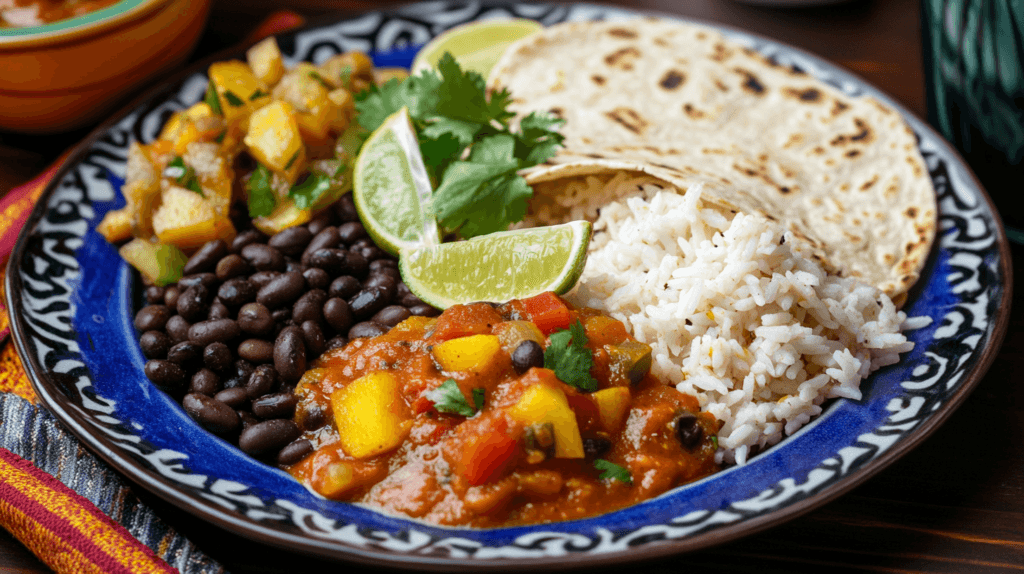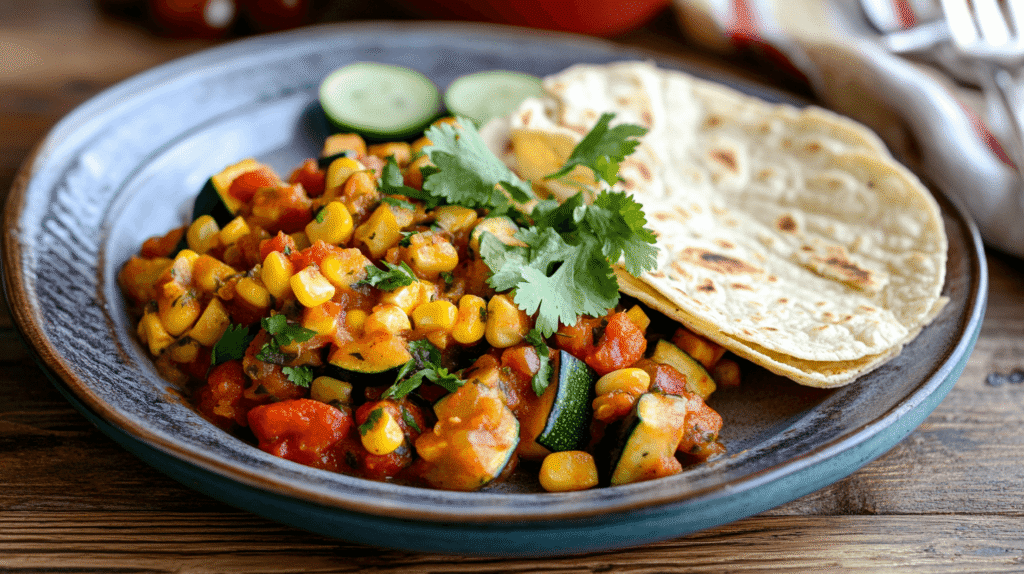Calabacitas recipe is a must-try for anyone seeking a dish that’s both irresistibly tasty and incredibly healthy. This traditional Mexican dish, whose name translates to “little squash,” combines zucchini, corn, tomatoes, and a medley of spices into a colorful and flavorful creation. Packed with nutrients, bold flavors, and a rich cultural history, Calabacitas is perfect as a comforting vegetarian meal or a delicious side dish to complement any meal.
The origins of Calabacitas date back centuries, rooted in indigenous Mexican cuisine that prized the three sisters—corn, beans, and squash—for their nutritional and agricultural harmony. Today, this dish remains a staple in Mexican households, cherished for its simplicity, versatility, and rich cultural significance. Whether you’re a seasoned cook or a kitchen newbie, this recipe will help you whip up a delightful plate of Calabacitas in no time.
Table of Contents
What Are Calabacitas?
Before diving into the recipe, let’s explore what Calabacitas really means. The word “calabacitas” is Spanish for “little squash,” and it typically refers to zucchini or other summer squashes. However, the dish itself is much more than just squash. It’s a medley of fresh vegetables sautéed together to create a satisfying, savory masterpiece.
What sets Calabacitas apart is its adaptability. You can make it as a vegetarian main course, a hearty side dish, or even add meat or cheese to suit your preferences. It’s comfort food at its finest—healthy, flavorful, and incredibly easy to customize.
Ingredients for Calabacitas
One of the best things about Calabacitas is its simplicity. The ingredients are easy to find and can be adjusted based on what’s in your pantry or fridge. Here’s what you’ll need for a classic Calabacitas recipe:
Essential Ingredients
- 2 medium zucchinis: Sliced into half-moons; these form the heart of the dish.
- 1 cup fresh or frozen corn kernels: Adds a natural sweetness and crunch.
- 2 medium tomatoes: Diced for a juicy, tangy base.
- 1 small onion: Chopped finely for flavor depth.
- 2 cloves of garlic: Minced to enhance the aromatic profile.
- 1 tablespoon vegetable oil: For sautéing the vegetables.
- 1 teaspoon cumin: Adds a warm, earthy undertone.
- 1 teaspoon chili powder: For a touch of heat.
- Salt and pepper to taste: To balance and enhance the flavors.
- 1/4 cup fresh cilantro: Chopped for garnish, adding a burst of freshness.
Optional Ingredients
- 1 cup shredded cheese (such as Monterey Jack or queso fresco): For a creamy, indulgent twist.
- 1 diced jalapeño or serrano pepper: If you want to kick up the spice level.
- Protein options: Cooked ground beef, shredded chicken, or diced pork for a more filling meal.
- Squash blossoms: A traditional Mexican addition that elevates the dish.
With these ingredients, you’re ready to create a vibrant dish that brings the essence of Mexican cooking to your kitchen.
Step-by-Step Instructions

Cooking Calabacitas is a breeze! Follow these steps for a foolproof recipe that delivers every time.
Step 1: Prepare the Vegetables
Start by washing and prepping all your vegetables:
- Slice the zucchinis into thin half-moons.
- Dice the tomatoes and onion.
- Mince the garlic.
- If using fresh corn, remove the kernels from the cob.
Step 2: Cook the Base
- Heat the vegetable oil in a large skillet over medium heat.
- Add the onion and garlic, sautéing until fragrant and translucent (about 2 minutes).
- Stir in the diced tomatoes and let them cook down, creating a juicy base.
Step 3: Combine the Ingredients
- Add the zucchini slices, corn kernels, cumin, and chili powder to the skillet.
- Stir well to coat the vegetables in the seasoning, then cover the skillet with a lid.
- Cook for 7–10 minutes, stirring occasionally, until the zucchini is tender but not mushy.
Step 4: Finish and Garnish
- Taste the dish and adjust the salt and pepper as needed.
- If using cheese, sprinkle it on top during the last minute of cooking, allowing it to melt.
- Garnish with fresh cilantro before serving.
Tips for Perfect Calabacitas
Here are a few tips to ensure your Calabacitas turns out perfectly every time:
- Pick the freshest produce: Look for zucchinis that are firm and unblemished.
- Don’t overcook the vegetables: Keep the zucchini tender-crisp for the best texture.
- Layer the flavors: Add spices gradually and adjust as you go.
- Experiment with add-ins: Try bell peppers, squash blossoms, or even a squeeze of lime juice for extra zest.
Variations of Calabacitas
One of the reasons Calabacitas is such a beloved dish is its adaptability. You can tweak the recipe to suit your dietary preferences, spice tolerance, or even the ingredients you have on hand. Here are a few popular variations:
1. Cheesy Calabacitas
Adding cheese transforms this dish into a creamy, indulgent delight. Some great cheese options include:
- Monterey Jack: Melts smoothly and adds a rich flavor.
- Queso Fresco: Crumbled on top for a light and tangy finish.
- Cheddar: For a bolder, sharp taste.
Simply sprinkle the cheese over the cooked vegetables and cover the skillet for a minute or two to let it melt.
2. Vegan Calabacitas
Skip the cheese and focus on the vegetables and spices for a vegan-friendly version. You can enhance the creaminess by:
- Adding a tablespoon of nutritional yeast.
- Tossing in a handful of avocado cubes before serving.
3. Meaty Calabacitas
If you’re looking to make this dish more filling, incorporate your favorite protein:
- Chicken: Add cooked shredded chicken for a hearty twist.
- Ground beef or pork: Brown the meat before adding the vegetables.
- Shrimp: Cooked shrimp can be stirred in during the last few minutes of cooking for a seafood spin.
4. Spicy Calabacitas
Turn up the heat by adding:
- Jalapeños or Serrano peppers: Sauté these with the onions and garlic.
- Red pepper flakes: Sprinkle them in during cooking.
- Chipotle sauce: A drizzle will add smoky heat to the dish.
Serving Suggestions

Calabacitas is versatile enough to be served as a main course, side dish, or even part of a taco filling. Here are a few pairing ideas to complete your meal:
As a Main Dish
Serve Calabacitas on its own with a warm stack of corn or flour tortillas. Add a side of Mexican rice or a small bowl of black beans to round out the meal.
As a Side Dish
Calabacitas pairs beautifully with:
- Grilled meats such as chicken, steak, or pork chops.
- Enchiladas, tamales, or chile rellenos.
In Tacos or Burritos
Spoon the Calabacitas into a tortilla with your favorite toppings like salsa, guacamole, or sour cream for a quick and delicious taco or burrito filling.
Nutritional Benefits
Not only is Calabacitas delicious, but it’s also a powerhouse of nutrition. Here’s why it’s a great choice:
1. High in Vitamins and Minerals
- Zucchini is rich in vitamin C, potassium, and antioxidants, which promote a healthy immune system and skin.
- Corn provides fiber and essential B vitamins, supporting energy levels and digestion.
2. Low in Calories
Calabacitas is naturally low in calories, making it a guilt-free option for those watching their weight.
3. Heart-Healthy
With fresh vegetables, minimal oil, and no heavy creams, this dish is heart-friendly and helps reduce cholesterol.
4. Vegan and Gluten-Free
The base recipe is naturally vegan and gluten-free, making it suitable for a variety of diets.
Common Mistakes to Avoid
Even a simple dish like Calabacitas can go wrong if you’re not careful. Here are some pitfalls to watch out for:
1. Overcooking the Vegetables
Zucchini cooks quickly, and overcooking can lead to mushy, unappetizing vegetables. Aim for tender-crisp zucchini for the best texture.
2. Skipping the Spices
The beauty of Calabacitas lies in its flavors. Don’t skimp on cumin, chili powder, or salt, as they elevate the dish.
3. Not Prepping Ingredients Properly
Chopping the vegetables into even pieces ensures consistent cooking and a more visually appealing dish.
Regional Variations
The beauty of Calabacitas is that it varies slightly depending on the region in Mexico. Here’s a quick look at some regional takes:
- Northern Mexico: Often includes chorizo or pork for a heartier version.
- Central Mexico: Features squash blossoms and a touch of epazote for an herbal note.
- Southern Mexico: Sometimes made with regional cheeses like Oaxaca or Cotija.
Storing and Reheating
Calabacitas makes excellent leftovers if stored properly. Here’s how to keep it fresh:
- Refrigeration: Store in an airtight container for up to 3 days.
- Freezing: While the texture of zucchini may change slightly, you can freeze the dish for up to 2 months. Thaw in the fridge overnight before reheating.
- Reheating: Warm it up in a skillet over medium heat or in the microwave for a quick meal.
FAQs About Calabacitas
1. What does “Calabacitas” mean in English?
“Calabacitas” translates to “little squash,” referencing the zucchini or summer squash that’s the main ingredient in the dish.
2. Can I freeze Calabacitas?
Yes, but zucchini may soften after freezing. Cool the dish completely, store in an airtight container, and freeze for up to 2 months. Thaw in the fridge and reheat in a skillet. To enhance the flavor after freezing, consider serving it with delicious side dishes that complement Mexican flavors.
3. What cheese works best with this dish?
Monterey Jack, queso fresco, or cheddar are great options. Choose one based on whether you prefer creamy, tangy, or bold flavors.
4. Are Calabacitas keto-friendly?
Yes, omit the corn to reduce carbs and enjoy a low-carb, keto-friendly version. Learn more about exploring low-carb and keto options for Mexican dishes to customize recipes to your diet.
5. How can I make this spicier?
Add jalapeños, serrano peppers, chili flakes, or a splash of hot sauce to dial up the heat. For those looking for creative uses of versatile ingredients, check out versatile vegetables for nutrient-packed meals.
6. Can I make Calabacitas without tomatoes?
Yes, replace tomatoes with a splash of vegetable broth or roasted red peppers for a different base. If you’re preparing a side dish to pair with your Calabacitas, these simple techniques for preparing flavorful dishes will come in handy.
Conclusion
Calabacitas is a delightful way to enjoy fresh, healthy ingredients with bold Mexican flavors. Whether you prepare it as a comforting main dish, a side, or a taco filling, its versatility ensures there’s a version for everyone. Add cheese for indulgence, protein for a hearty twist, or spices for extra heat—this dish adapts beautifully to your taste.
Try this timeless recipe today and bring a touch of authentic Mexican cuisine to your table. You’ll love how easy and satisfying it is to make. Enjoy!
Printable Recipe Card
Want just the essential recipe details without scrolling through the article? Get our printable recipe card with just the ingredients and instructions.

